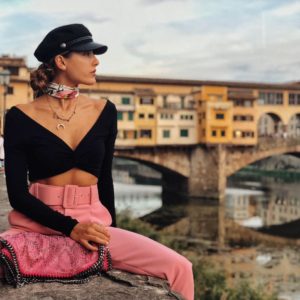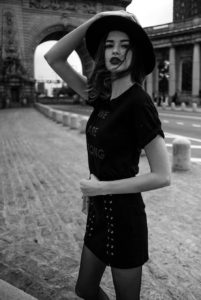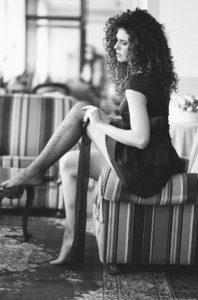
La luce è l’arcata della pelle – The light is an arcade of the skin
Citiamo una conta ritmata che s’usa in Italia: < Ponte ponente ponte pì, tappetà Perugia, ponte ponente ponte pì, tappetà perì >. Ad essa non associamo alcun significato. Ma il ponte è materialisticamente costruito per connettere! Paola ha posato a cavalcioni sul muro del lungarno, a Firenze. Dietro di lei, noi riconosciamo il Ponte Vecchio. Paola è stata inquadrata di ¾, ma col collo assai in torsione, sino a “ribaltare” il ciondolo a mezzaluna (dalla gobba forse a ponente o forse a levante…) in mezzo al petto. L’abbigliamento sembra quasi cromaticamente a rima alternata: c’è il berretto nero, poi il foulard rosa; c’è il top nero, poi il rosa dei pantaloni. Nessuno può risalire a cosa pensi Paola. Ma ci pare che lei usi la mano destra come un… “carrello d’atterraggio”, per un centrino rettangolare (dove permangono i toni del rosa e del nero).
We mention a counting-out rhyme that is used in Italy: < Ponte ponente ponte pì, tappetà Perugia, ponte ponente ponte pì, tappetà perì >. There we can not give any meaning. However a bridge (from the Italian word < ponte >) is materialistically built to connect! Paola posed with legs astride on the wall of Arno embankment, in Florence. Behind her, we recognize the Old Bridge. Paola was framed in ¾ view, but with the neck very in torsion, until it “overturns” the pendant in a half moon (with the bump maybe in the West or rather in the East…) in the middle of the chest. The clothing seems almost chromatically in alternating rhymes: there is the black cap, then the pink foulard; there is the black top, then the pink of the trousers. Nobody can discover what Paola is thinking. But it seems to us that she uses the right hand like a… “landing gear”, for a rectangular doily (where the tones of the pink and the black remain).

Per il poeta Barker, la vita è simboleggiabile dall’arco nuziale alla corona di fiori, passando per la “croce” del volto (il primo canale per conoscere qualcuno), fra il naso e gli occhi. Se il caso inciderà favorevolmente, come da un quadrifoglio, alla fine ci resterà pur sempre una clessidra vuota. Certo si potrà sperare in una pietra della resurrezione (citando il racconto evangelico del Santo Sepolcro). La fotografia di Marija è in bianconero. Immaginiamo il mezzobusto “a clessidra”, mediante la piega delle braccia. Il gomito destro quasi “s’incastra” nella luce d’un arco monumentale. Inoltre, tale dinamismo comporta lo sdoppiamento innaturale del volto. Tutta la serie di lacci incrociati nella minigonna si sarebbe “rialzata” tramite i dissuasori stradali, ma avendo per direzione il superamento del varco. Proprio là “curva” il delineatore del braccio destro. Marija indossa una maglietta con la scritta, da completare probabilmente al < Noi siamo forti >. Il cappello ha una falda circolare, e ci sembra alzato in segno di saluto per la nostra conoscenza.
According to the poet Barker, we can symbolize the life from a nuptial arch to a wreath, passing from a “cross” of the face (the first channel to know somebody), between the nose and the eyes. If the chance will favourably influence, like a four-leafed clover, finally however an empty hourglass will remain for us. Of course we could hope in a rock for the resurrection (mentioning the evangelical story of the Holy Sepulchre). The Marija’s photography is in black and white. We imagine the head and shoulders “in hourglass”, through the folding of the arms. The right elbow almost “is wedged in” the opening of a monumental arch. In addition, this dynamism implicates the unnatural doubling of the face. All the series of the crossed laces in the miniskirt would have been “picked up again” through the traffic dissuaders, but having as its direction the crossing of the arch. Exactly there a chevron sign of the right arm “curves”. Marija wears a t-shirt with a writing, that we have to complete probably by a < We are strong >. The hat has a round brim, and seems to us lifted in greeting for our knowing.

Per Jonathan Swift, ironicamente le vecchie scienze si srotolano come le vecchie calze, ossia iniziando dai piedi. I presupposti al massimo “rivestono”, e sono sempre “ballerini”. Maily appare seduta sul divano, che ha le righe verticali. La fotografia è lasciata in bianconero. Maily posa alle prese con le calze, tanto “controllate” dallo sguardo quanto “aggiustate” dalle mani. Le gambe s’accavallano quasi a “ruota di mulino”. Le calze hanno i pois diradati, mentre le scarpe sono assenti. Nell’insieme, immaginiamo un design a prove tecniche di trasmissione… Una donna vorrà curare il suo aspetto, per ipnotizzarci attraverso gli “sbandamenti” della seduzione.
According to Jonathan Swift, ironically the old sciences are unrolled like the old stockings, namely starting from the feet. The assumptions if anything “upholster”, and are always “fickle”. Maily appears sitting on the couch, which has the vertical stripes. The photography is left in black and white. Maily poses faced with the stockings, as much “controlled” by the gaze as “adjusted” by the hands. The legs overlap each other almost in a “mill wheel”. The stockings have the thinned out polka dots, while the shoes are absent. On the whole, we imagine a design by the technical tests for the broadcasting… A woman would take care of her look, to hypnotize us through the “disbandments” of the seduction.

Mirò ha ammesso quanto lo “sconvolga” il vedere, nel cielo immenso, il sole o la falce della luna. Questi, al di là della propria “solitudine”, riescono a rivitalizzare il mondo. Di conseguenza, Mirò amava dipingere nei quadri forme minuscole in spazi vuoti, ma da “rasserenare” tramite l’incanto del surrealismo. La fotografia mostra due ragazze, che sono state inquadrate dandoci le spalle. Sullo sfondo, il campo dall’erba bassa pare chiuso da una siepe, intervallata da alberi la cui chioma riceve la luce solare. Una ragazza veste i quadretti, in blu e nero, appoggiandosi con la testa alla spalla destra della sua amica. Il contorno dei corpi riceve la luce, pure “espansa” dai capelli. In questo modo, è un ritratto che sia “falcia” (al centro) sia “raggira” (a destra) la linea d’orizzonte (sulla siepe). I quadretti del vestito hanno un tono “notturno”, che “mette a riposo” tramite la testa in appoggio sulla spalla. Il campo forse non è larghissimo, ma “si vuota” anche graficamente. La luce del sole unicamente sulle chiome più alte diventa surreale, se le ragazze la ricevono servendosene da “asta” (con la “falce” od il “raggiro”) per “saltare” oltre il “buio” della siepe.
Mirò acknowledged how much he is “upset” by the sight of the sun or the crescent moon, in the immense sky. Those, beyond the own “solitude”, are able to revitalize the world. Consequently, Mirò loved to paint, in the pictures, the minuscule shapes in the empty spaces, but in their “appeasement” through the enchantment of the surrealism. The photography shows two girls, who were framed turning their back to us. On the background, the field with the short grass seems closed by a hedge, interrupted by the trees whose foliage receives the sunlight. A girl wears the small squares, in blue and black, leaning with the head on the right shoulder of her friend. The contour of the bodies receives the light, also “expanded” by the hair. In this way, we have a portrait that in the same time “scythes” (in the middle) and “circumvents” (on the right) the horizon line (on the hedge). The small squares of the dress have a “nocturnal” tone, which “sets aside” through the head leaning on the shoulder. The field perhaps is not very wide, but “is emptied” also graphically. The sunlight only on the highest foliages becomes surreal, if the girls receive that one using it as a “pole” (with the “scythe” or the “circumvention”) to “jump” beyond the “darkness” of the hedge.

Bibliografia consultata – Annotated bibliography:
V. ONGINI, Grammatica dell’integrazione, Laterza, Roma-Bari 2019
A.T. TOLLEY, The poetry of The Forties, Manchester University Press, Manchester 1985, pp. 71-72
R. DEMARIA, British literature: 1640-1789, Wiley & Sons, Chichester 2016, p. 502
C. PEARSON, Designing Unesco, Routledge, Abingdon on Thames 2016, p. 271
Nota biografica sui nove artisti recensiti – Biographical sketch about the nine artists:
La modella Paola Lavanzini nasce a Lugano (Svizzera). Lei ha studiato Fashion marketing and management.
The model Paola Lavanzini was born in Lugano (Switzerland). She studied Fashion marketing and management.
https://electioestua.wordpress.com/author/electioestua/
La fotografa Samia Cynthia Barghout vive a Firenze (Italia). Lei ha studiato Fashion marketing and management.
The photographer Samia Cynthia Barghout lives in Florence (Italy). She studied Fashion marketing and management.
La modella internazionale Marija Shatilo nasce a Vilnius (Lituania). Lei ha studiato Psicologia.
The international model Marija Shatilo was born in Vilnius (Lithuania). She studied Psychology.
Il fotografo Andris Dzeguze viene da Achtubinsk (Russia). Egli oggi lavora negli USA, in specie per la Fashion Week.
The photographer Andris Dzeguze comes from Akhtubinsk (Russia). Today he works in the USA, especially during the Fashion Week.
http://www.andrisdzeguze.com/
La modella Maily Boschieri viene da Vicenza (Italia). Lei ha studiato Storia dell’arte, e dirige la Mariposa Agency (che organizza eventi).
The model Maily Boschieri comes from Vicenza (Italy). She studied Art history, and manages the Mariposa Agency (organizing events).
https://www.mariposagency.it/
Il fotografo Paolo Darcoli viene dalla Provincia di Vicenza (Italia). Egli è anche un violinista.
The photographer Paolo Darcoli comes from Province of Vicenza (Italy). He is also a violinist.
La modella italiana Chiara Baggio viene da Cittadella (Provincia di Padova). Lei ha studiato design e contenuti creativi.
The Italian model Chiara Baggio comes from Cittadella (Province of Padua). She studied design and creative contents.
La fotografa italiana Nicole Binotto viene da Pozzoleone (Provincia di Vicenza). Lei oggi lavora nel settore immobiliare.
The Italian photographer Nicole Binotto comes from Pozzoleone (Province of Vicenza). Today she works in the real estate sector.
P.S. Avvertenza – Instructions
Una modella di Nicole Binotto ha richiesto di farsi citare genricamente come Chiara.
One model of Nicole Binotto requested to be mentioned generically as Chiara.

+ Non ci sono commenti
Aggiungi